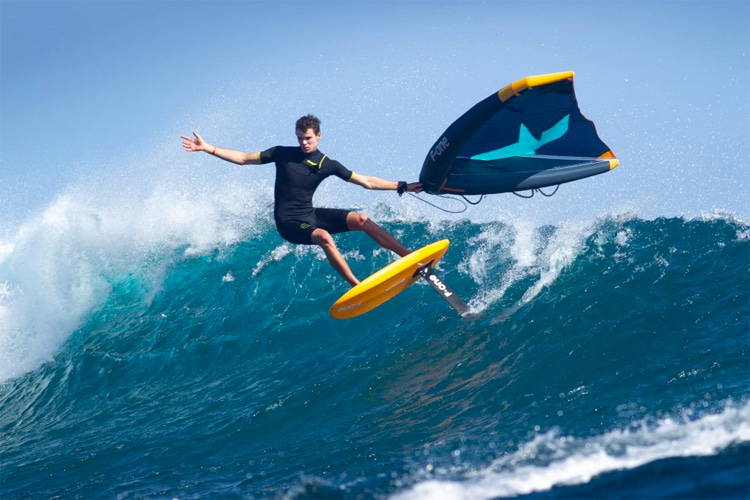Wing surfing is the sport of riding a foil board - or a standard SUP - while carrying a hand-held inflatable sail.
Wing surfing is not supposed to replace windsurfing, kiteboarding, and surfing. It's a complement, an addition, an alternative, and a subgenre of wave riding and sailing.
Wing surfing was not designed to ride faster or jump higher. That's not the point.
It's all about carving around, having fun, and bringing the wind element to water sports enthusiasts who have only experienced wave riding and have never sailed before.
Hidden in the Attic
Hand-held wings have been around for decades.
In the mid-1980s, inspired by seagulls, Tom Magruder developed the Wind Weapon, a rigid sail that rotated freely on a windsurf board.
"If you look at a bird, it has the ability, through its own energy, to add to the lift of the wind and stay in flight indefinitely," explained the inventor.
"We could do that, too. With the Wind Weapon, I get the aerodynamic control of a true wing that pitches and yaws and rolls like a bird or an airplane."
Magruder relied on his experience as a windsurfer and hang glider pilot to create a pivoting wing that, however, never lifted off, commercially speaking.
Later, in the 2000s, a couple of water sports companies developed a few inflatable wing prototypes that could be used with SUPs.
But the products never saw the light of day.
Meanwhile, snow windsurfers used similar portable sails to glide across frozen lakes and compete in ice sailing world championships.
With the rise of the hydrofoil era, hand-held inflatable sails conquered a space of themselves and a potentially interesting market share.
The Hand-Held Sail
The equipment is relatively easy to put together. It has no rigging components, no lines, bars, booms, or masts.
All you have to do is inflate the lightweight wing and get to the water. Simplicity is the concept behind it.
The size of a standard all-around sail ranges around four square meters, and it generates enough power to get you going in flat water bodies.
Actually, if you're on a hydrofoil board, you'll only need 12 knots of wind to start sailing. Wing surfing is not about riding strong winds above 25 knots.
Although it was conceived to be used with a foil board, it can also be adopted for riding stand-up paddleboards (SUP), windsurf boards and kiteboards, and even skateboards and snowboards.
"It is also a lot of fun on a big touring SUP board. It's difficult to paddle when it's windy, especially with five or ten knots. With an inflatable wing, it's easy and entertaining," notes Robby Naish, the developer of the Wing-Surfer.
If you're riding a SUP board, then five knots of wind will get you faster than you can paddle.
Wing surfing allows you to go upwind and downwind.
Ideally, you'll need a big board, somewhere between a 95 and 135-liter foil board with or without foot straps.
You don't need a harness to hold the portable sail because it has little resistance. When you're up and riding, it actually creates lift.
The whole flexible structure weighs nothing at all; it is light in the hands and lets you sail for hours.
It comes with a wrist leash that is attached to the leading edge of the sail. If you need to let go of the sail or wipe out, the wing is not going anywhere.
The inflatable sail also features soft handles positioned all along the center of the wing, Kevlar-reinforced patches on the leading edge, and packs into a small backpack quickly.
Simple and Fun
The wing surfing sail doesn't have a window because, most of the time, you know where you're going.
If you want to see what's downwind of you, lift it up and have a quick look.
Unlike in windsurfing, you're not riding the sail vertically - you're constantly changing between having it over your head and having it sideways.
To sailing and surfing, get on your knees over the board, sheet in, get up on one leg, and then stand up and sail away.
Riders should only ride the hand-held wing on a foil when they're already acquainted with foil boarding.
If you've never foiled, learn how to do it before trying wing surfing, or try it with a SUP board.
